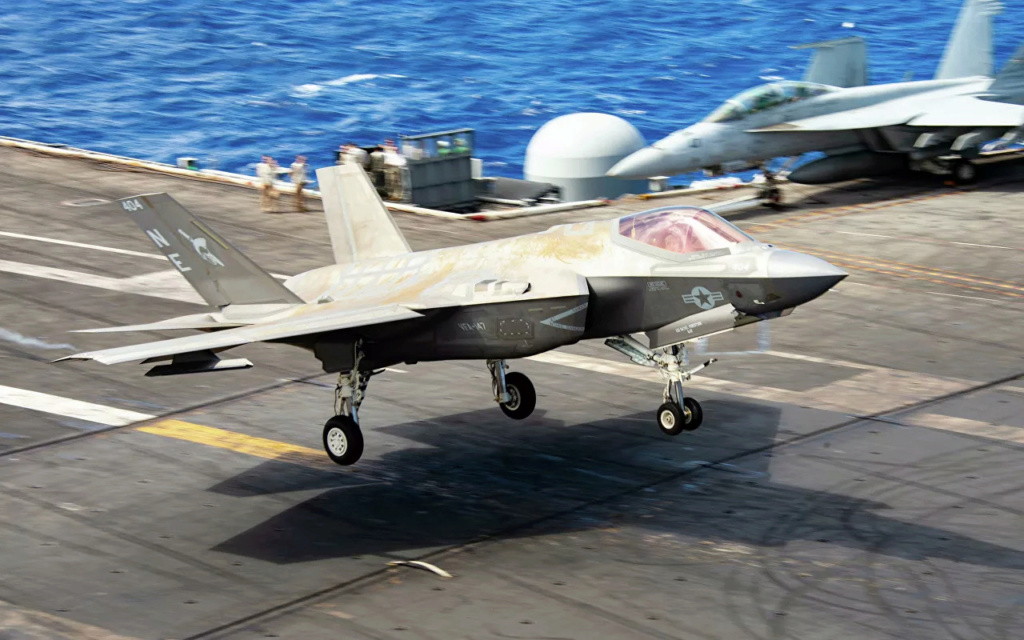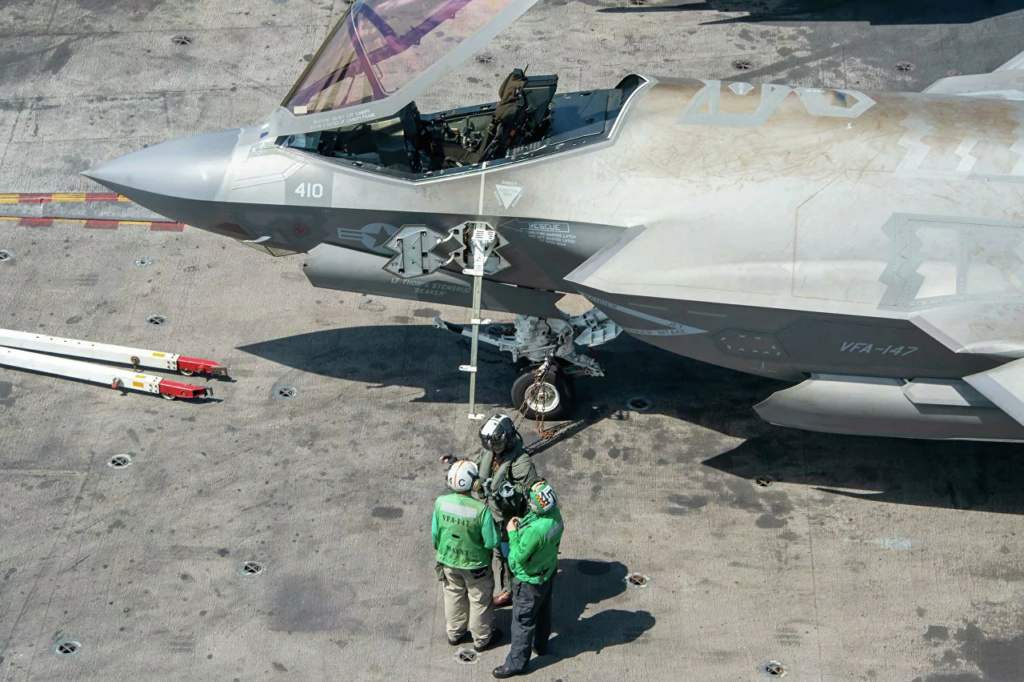You're just repeating Abhirup Sengupta's nonsense.
bitcointrader70 wrote:Su35 has absolutely zero chance against the f35.
The Su-35 can detect the F-35 before it enters the NEZ of the AIM-120D, which has an active X-band radar terminal seeker using a solid-state transmitter and a built-in radio frequency processor. The only wavelengths that the AMRAAM operates on is the 8-10 GHz X-band frequency range, which is easy to be blocked by the DRFM-capable Sorbitsya Russian ECM systems and the new KNIRTI Khibiny blocking pods carried by the variants. from Flanker.
The KNIRTI L175M Khibiny M jamming system uses multiple techniques, including DRFM and spot-jamming, to which AMRAAM is particularly susceptible.
DRFM (Digital Radio Frequency Memory) blocking or replay blocking is a replay technique that manipulates incoming radar energy and retransmits it to change the echo that the radar sees. This technique can change the range the radar detects by changing the delay in transmitting pulses, the speed the radar detects, changing the doppler shift of the transmitted signal or the angle to the plane using AM techniques to transmit on the radar side lobes.
The AIM-120B/C/D's home-on-jam (HOJ) feature works when the missile's receiver detects signals that did not come from its transmitter, and locks onto the source transmitting them.
But the HOJ feature doesn't work against DRFM.
The DRFM used in KNIRTI is more advanced; DRFM digitizes the received signal and stores a coherent copy in digital memory. When necessary, the signal is replicated and retransmitted. Being a coherent representation of the original signal, the transmitting radar will not be able to distinguish it from other legitimate signals it receives and processes as targets.
As the signal is stored in memory, it can be used to create false targets behind (reactive blocking) and in front (predictive blocking) of the target intended for protection. KNIRTI goes a step further, generating signals that indicate a false distance and location for passive guidance on the HOJ.
Spot jamming occurs when a jammer focuses all of its energy on a single frequency. While this severely reduces the ability to track the jammed frequency, a frequency agility radar would hardly be affected because the jammer can only jam one frequency at a time. However, the AIM-120D can only operate in the X-band frequency range.
The KNIRTI L175M jammer is said to be an effective ECM against more advanced AESA radars, so it can easily confuse the AMRAAM's radar detection head.
Russia also produces other ECM systems, one of which is the SAP 518, used in the Su-30 and Su-34. SAP 518 is DRFM class too and is produced by KNIRTI (Kaluga Research Radio Engineering Institute).
The manufacturer says it operates in the 2-18 GHz range and is also made to jam radar-guided air-to-air missiles like the AIM-120.
Your idea that the Su-35 has absolutely zero chance against the F-35 is just bullshit.
bitcointrader70 wrote:The technical result, the achievement of which the invention is directed, is to reduce the magnitude of the aircraft radar visibility to an average value of the order of 0.1 – 1 m 2 .
"Russian designers say that while 4 generation fighters using almost 5 generation technology showed up on radar as objects the size of a football(~0,038m2), the T-50 shows up on radar as a object the size of a tennis ball(0,0033m2)..."
https://youtu.be/KvyAbM67yKI
Well, you see the video, read the patent and maybe you're wondering "why do they have such different RCS values?", well the reason is simple, any aircraft doesn't have one RCS value, the RCS varies with a lot of parameters such as the direction the radar is pointing at the aircraft, just as radars operating in different bands can get different RCS values against the same aircraft.
The Su-57 having an RCS of 0.1-1m2 from unspecified angles and frequencies will not prevent him from getting lower RCS values in other circumstances.
bitcointrader70 wrote:That’s comparable to a clean Super Hornet and it shouldn’t be a surprise when Su-57 follows many of the same RCS-reduction measures such as using radar blockers to hide the engine face instead of an actual serpentine duct.
Radar blockers were used on the F-117 and X-32, and that never stopped them from being considered stealthy and unless these RCS values were obtained at the same aspect angle, frequency and polarization, which I doubt, this is a silly comparison.
The main solution to reduce radar visibility is internal carriage of weapons.The shape of the airframe must be selected to reduce the number of directions in which electro-magnetic waves are reflected, and to ensure these directions are the safest. SU-57 has canted and mostly serrated surfaces to redirect radar energy. It’s smoother and more streamlined with less discontinuities. The F-18, with the exception of the v-tails, and intakes has no other canted surfaces, there are no trapezoid style shaping in the wings or bays and its full of discontent.
The NO36 radar arrays are deflected from the vertical plane, thus deflecting the enemy radar’s radiation aside. The domes of the arrays are selective, they let their own signal pass through and block other frequencies. In addition, the compartments for these arrays feature RAM coatings on their edges to absorb ‘freak waves’ (which occur when a wave is amplified after multiple reflections within an enclosed space).
It is impossible for an F-18 to ever match the RCS of the SU-57.
bitcointrader70 wrote:It’s not just Su-57 being less stealthy than F-35 (-40 dBsm) – it has a 1,000 times bigger RCS. Since detection range is proportional to the 4th root of RCS, a 1,000 times bigger RCS equates to 5.6 times greater detection range. And this is after giving Su-57 every benefit of doubt, the F-35’s RCS is very likely closer to -50 dB.
Having an RCS of -40 dBsm at a narrow angle is useless:
https://basicsaboutaerodynamicsandavionics.files.wordpress.com/2016/03/f_35_metal_rcs.png?w=768
The slightest change in the position of the radar relative to the aircraft would change the RCS tens or even hundreds of times.
The average RCS is much larger:
https://pbs.twimg.com/media/FDhFxjtVUAoCDvs?format=jpg&name=large
bitcointrader70 wrote:The F-35 has a bigger and much more capable radar and orders of magnitude more powerful EW suite giving vastly superior Situational Awareness.
The Su-35's radar has a range against air targets of up to 350km and a sector of vision in azimuth is ± 120°.
In comparison, the APG-81 has a range of up to 160km and an azimuth vision sector of ±60°. And this gap will certainly be even bigger when compared to the Su-57's radar.
and in terms of EW there is nothing the F-35 does that the flankers already do with their electronic warfare pods.
bitcointrader70 wrote:
Where F-35’s DAS make it the only Fighter to fully operate in the IR spectrum
About the Su-35:
"the I-222 optoelectronic reconnaissance system developed by NPK SPP provides detection of air targets by INFRARED radiation with selection of missiles attacking the aircraft, as well as aircraft laser irradiation detection..."
https://www.sukhoi.org/products/samolety/256/
bitcointrader70 wrote:while turning a blind eye to the fact Su-57 use a UV based Missile Warning System – making Su-57 significantly vulnerable to BVR missiles.
And you are turning a blind eye to the advantages of using the UV sensor.
The MAWS sensors that operate in the ultraviolet spectrum (from 0.2 to 0.5 microns) are used to detect the emissions from the burning of the engine jets, taking advantage of the fact that the ozone layer filters the ultraviolet energy from the sun. This means that few natural sources could give false alerts like welders, halogen lamps, fires and sparks. The ultraviolet spectrum also penetrates battlefield smoke, contributing to its efficient use in detecting missile launches.
Another advantage is that they are small and do not need refrigeration.
bitcointrader70 wrote:forcing Su-57 to fly with R-77, R-74 externally (as they won’t fit inside).
doesn't fit inside?!
The Su-57 has two tandem main internal weapon bays each approximately 4.4 m (14.4 ft) long and 0.9 m (3.0 ft) wide, the R-77 has a length of 3.6m, a diameter of 200mm and a wingspan of 350mm, the Su-57 can carry a minimum of 4 R-77s internally.
bitcointrader70 wrote:
of non-existent L band radar.
Unfortunately for you it exists, and it will give the Su-57 capabilities that F-35 pilots can't even dream of.
Search, track and missile midcourse guidance against low signature aircraft.
Identification Friend Foe / Secondary Surveillance Radar.
Passive angle tracking and geolocation of JTIDS/MIDS/Link-16 emitters at long ranges.
Passive angle tracking and geolocation of L-band AEW&C/AWACS and surface based search radars at long ranges.
Passive angle tracking and geolocation of hostile (i.e. Western) IFF and SSR transponders at long ranges.
High power active jamming of JTIDS/MIDS/Link-16 emitters.
High power active jamming of satellite navigation receivers over large areas.
High power active jamming of L-band AEW&C/AWACS and surface based search radars at long ranges.
High power active jamming of guided munition command datalinks over large areas.
http://www.ausairpower.net/APA-2009-06.html




 Belisarius
Belisarius

